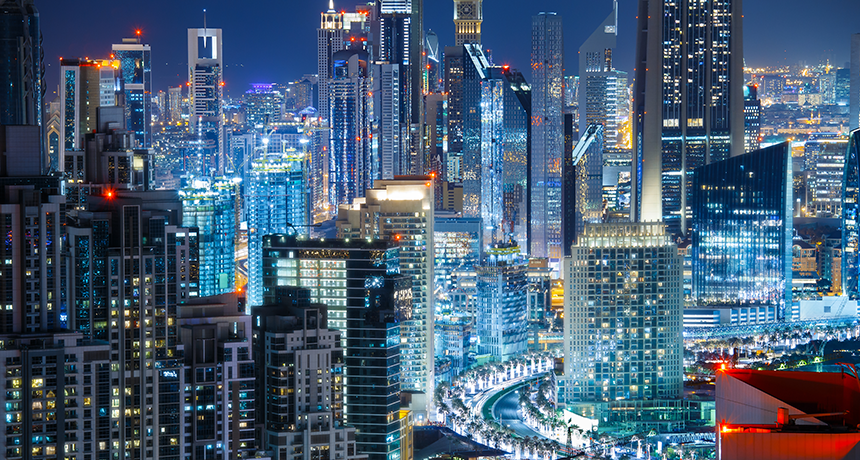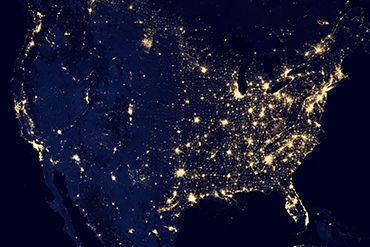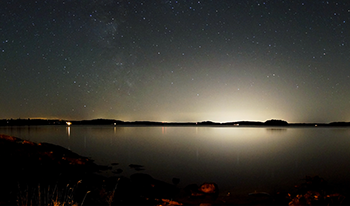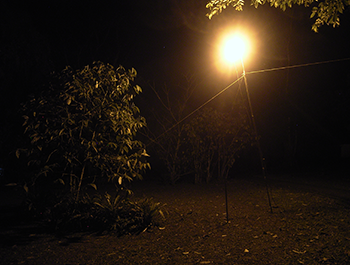Night lights have a dark side
Artificial light at night impairs stargazing, animal behaviors — and maybe even human health

Major cities can easily be seen from space at night owing to the huge outpouring of light they emit. They also can be seen from a great distance, on the ground, due to the way they produce a dome of overhead light known as sky glow.
Britus/iStockphoto
In 1994, an earthquake knocked out power in Los Angeles, Calif. In the days that followed, concerned residents reported a giant cloud of silvery light stretching across the night sky. Some worried that the mysterious sight was somehow related to the earthquake. These people had lived in the large, brightly lit city their entire lives. Many had rarely seen stars. They certainly had never before seen this night-sky cloud of light.
It was the Milky Way — our galaxy!

Until this blackout, city lights had for decades blocked such dim light arriving from the distant reaches of space.
When artificial (human-made) light spills into areas where it’s not wanted, it’s called light pollution. Indeed, it is considered one of the biggest forms of pollution. It prevents two-thirds of U.S. residents and half of those in Europe from viewing the Milky Way. And light pollution increases every year, as cities continue to grow.
That doesn’t mean electric lights are bad. They have allowed people to work and play beyond sundown for roughly a century. Lights along roadways can make driving safer. In many ways, lighting up the night has been a good thing.
But there can be drawbacks. Sometimes lights that are meant to be helpful pose unintended harms. And this problem goes beyond our ability to enjoy the night sky.
Research is revealing that light pollution can alter the behavior of plants, animals and people. Some unnatural light-dark cycles may even make us sick.
Story continues below image.

Lighting the night
More than 8,000 stars should be visible without a telescope. Up to 4,000 of those can be seen at one time. (The others hide below the horizon.) But to see most stars requires gazing well away from cities or other populated areas. People living in urban areas see only a tiny fraction of stars that were visible to our ancestors. Take, for example, New York City. People in the outer suburbs can spot about 250 stars on a cloudless night. Those closer to downtown, in Brooklyn or Queens, might see just 50 stars. And someone in the middle of Manhattan would be lucky to spot 15.
What erases all of those stars from urban skies? Artificial light.
It takes our eyes about a half hour to fully adapt to the dark. Only then can we spot faint pinpoints of light coming from distant stars. But the moment we are exposed to brighter light — headlights, porch lights, flashlights or a cell phone screen — our eyes lose that adaptation to the dark.
And in our increasingly electrified world, such light pollution can be tough to avoid.

Light pollution comes in three forms, explains Jeremy White. He’s based in Fort Collins, Colo. There he studies this pollution for the Natural Sounds and Night Skies Division of the U.S. National Park Service. Direct light from a specific source, such as a flashlight or headlight, is called direct glare. Indirect light can be found in sky glow or light domes — the kind of light that lets you know a city is off in the distance. And light that intrudes into areas on the ground or on buildings where it’s not wanted is called light trespass.
With direct glare, light travels directly from the source of light into someone’s eyes. Glare tends to distract us from other — dimmer — things that we might be trying to see. It’s a problem for nighttime drivers faced with oncoming headlights or bright, flashy signs, White notes. It also can affect pedestrians by making it hard for them to see what might be lurking in the shadows.
Indeed, many people think security lights make them safer. But direct glare from many of these actually can make it harder to spot someone who doesn’t want to be seen.
Sky glow is indirect. When viewed from afar, it looks like a dome of light. That dome occurs when light runs into particles in the air — water vapor, smoke or other pollutants. These molecules scatter the light, creating a visible glow, White explains. The effect can be so great, he notes, that the sky glow from some city centers can be seen from 250 kilometers (155 miles) away!

Light trespass happens when a streetlight illuminates what should be a dark space. Or someone’s security light may shine on a neighbor’s house. “Whereas sky glow is in the air,” White explains, “light trespass is on the ground or buildings.”
All three are due to improper lighting, White says. Light at night is important. But we need that light in particular places on the ground, he says. Many street, porch and security lights beam light beyond where it needs to go. It can shine horizontally or up into the air. Brightly lit advertisements do this too. Horizontal light causes glare and trespass. Upward-shining light causes sky glow. Both can affect living things.
Altered behaviors
Almost all living things experience daily cycles, which repeat about every 24 hours. Such a cycle is called a circadian (Sur-KAY-dee-un) rhythm. Many plants bloom in the morning, others only at night. Animals search for food at specific times of day. Some sleep at night and eat during the day. Others eat at night and sleep during the day. The periods of light and darkness within a 24-hour period often control such behaviors.
When the lighted portion of a day-night cycle gets longer, the responses of plants and animals may change. For example, the number of hours of darkness determines when many trees grow leaves in the spring, when they flower and when they later go dormant in the fall. Not all plants are sensitive to light-dark cycles. But those that are and that live near streetlights or other all-night lights may not go dormant when or for as long as they would naturally. Instead, they grow all year long. That can make these plants less likely to handle stressful conditions well, such as drought or leaf predation by insects and fungi.
Animals, too, are affected by lights at night. And not just because their body clocks have been altered.
In large cities, lights inside buildings may be left on at night, even though no one is working. These lights attract migrating birds, which often travel at night. Such birds evolved to use distant, dim lights to guide their travels. Bright city lights may now confuse the birds. Drawn in, they circle a well-lit building like moths around a streetlight. This continues until the birds drop to the ground, exhausted. They are now vulnerable to other threats, such as dogs, cats or vehicles. Millions of birds die as a result of this artificial light at night each year, according to the National Audubon Society.
Brightly lit areas near beaches can cause a different type of problems for sea turtles.
Once a year, females come ashore at night just long enough to dig a hole into beach sand. There they lay a clutch of eggs. Water reflects light from the moon and stars. That usually makes the ocean appear brighter than the beach. Female turtles use this difference in lighting to find safe sites for their nests.
After laying their eggs, the turtles brush sand over them. Then they return to the sea, guided by the moon and starlight reflected on the water. Some two months later, baby turtles will hatch and claw their way out of those nests. They too use the natural glow of the moon and stars to find their way to the sea.

Or they did.
Urban lighting has been changing that. People have built hotels, resorts and houses along the beaches where sea turtles nest. At night, those well-lit buildings shine brighter than the ocean. This can disorient the turtles. People have reported finding adult females in swimming pools, parking lots and roadways, notes Gwen Oberholtzer. She is a lighting specialist with the Sea Turtle Conservancy in Gainesville, Fla.
Young turtles can similarly get confused. In Florida alone, Oberholtzer reports, “Tens of thousands of sea turtle hatchlings are disoriented each year.” Most eventually will die from exhaustion and thirst.
But even confused turtles that find their way to sea may not be home free. Many have simply wasted too much energy wandering, she explains, to survive as well as they would have in the past. That makes it less likely they will reach important offshore habitats that offer lots of food and few predators, she says.
It takes years for young turtles to reach breeding age. Until then, they live in the ocean. Only when these reptiles are old enough to lay eggs of their own will they briefly come ashore — and only to the nesting site of their birth. That years-long delay makes it hard for scientists to determine how lighting might have altered the health of a population of sea turtles born in any particular year.
Light pollution can affect bats, too. A few species reap benefits. They may find a dining bonanza among insects attracted to streetlights. But others may avoid lighted areas, notes Daniel Lewanzik. He’s a behavioral ecologist who studies bats and light pollution. (A behavioral ecologist studies how animals respond to different aspects of their environment.) Lewanzik now works at the Max Planck Institute for Ornithology in Seewiesen, Germany. Electric lights may prevent bats from reaching areas where they need to feed, he worries.

For a 2014 study, Lewanzik traveled to Costa Rica to probe the effects of night lighting on bat dining. Back then, he worked for the Leibniz Institute for Zoo and Wildlife Research in Berlin, Germany. He caught bats for one set of tests and put them in a flight cage. It had two smaller areas. Each of these contained peppers. It’s a favorite food of theirs. One side of the cage was well lit, the other dark. Between 6:30 p.m. and 2:00 a.m., he tallied how often the bats entered each enclosure. And they were more than twice as likely to eat on the dark side than on the one that was well lit.
To see if the bats behaved the same way in the wild, he recorded them searching for food in a rainforest. He located some pepper plants growing deep in the brush. Others were growing at a site lit at night by sodium vapor lights. These give off an orange glow. (They’re a type commonly used in streetlights.)
Bats ate all of the ripe fruit from plants in unlit areas within three hours of sunset, Lewanzik found. They visited lighted areas only after the other fruit was gone. What’s more, they didn’t eat all of it, as they had in unlit areas. They only ate 78 percent of the fruit on lighted plants. And this behavior was specific to electric lights. The natural light of a full moon did not deter their pepper dining, he found.
The color of night lighting also can make a big difference to wildlife.
Many streetlights emit red and infrared (In-frah-RED) wavelengths of light. The electromagnetic spectrum includes all types of light. Infrared is just beyond the red light that people can see. We detect infrared radiation as heat. Some plants use it to determine when to flower, since warmer nights are typically a sign that the climate has entered its warming cycle. Those plants may bloom earlier than normal when exposed to artificial light at night — but only on the side of the plant that receives that nighttime light.
Red light affects some birds. Migrating birds tend to use Earth’s magnetic field to find their way as they travel at night. But their brains seem to require blue-green wavelengths to take advantage of these magnetic-field cues. Certain wavelengths — longer ones in the red range — can interfere with a bird’s ability to use magnetic fields for guidance. So affected birds may fly off course. Studies have shown that replacing long-wavelength (reddish) lights with shorter-wavelength (greenish) ones helps migrating birds stay on course.
Light’s impacts on people
But short-wavelength artificial light isn’t always benign. Light-emitting diodes, or LED lights, often glow in this part of the light spectrum. These energy-efficient bulbs have become popular in recent years. And bright white ones emit lots of blue (short wavelength) light. This color can fool the body into thinking it’s daytime, even when our bodies may “know” it’s late at night.
The effect of these lights is particularly strong because LEDs are so much brighter than the moon or stars, notes White. These electronic bulbs prevent our eyes from adapting to the dark, he says. And they may show up everywhere, from lamps and digital-clock displays to night lights, tablet computers and smart-phone screens.

Given the growing prevalence of electronic devices, few people experience full darkness even in their homes at night. At bedtime, light from street lamps or cars bleeds in around the edges of window coverings. Even the tiny lights on charging electronic devices or the numbers glowing on a clock radio can disrupt our ability to see in the dark.
Perhaps surprisingly, such low levels of light at night also may affect health.
“Light at night disrupts sleep in humans,” notes Tracy Bedrosian. A researcher who focuses on genes and behavior, she works at the Salk Institute for Biological Studies in La Jolla, Calif. Impaired sleep, she points out, “can have many negative effects on health and behavior.”
But light at night does more than just deprive people of shuteye, she notes. It’s something she showed in tests with hamsters. As light fades in the evening, the brains of both people and hamsters produce a brain hormone called melatonin (Mel-uh-TOH-nin). It makes us feel ready to sleep. But her team showed that exposing hamsters to even dim light reduced the amount of melatonin their bodies made.
What’s more, the hamsters’ brains also showed a drop in the number of synapses present. Synapses are places between two nerve cells through which nerve signals travel. A similar decrease shows up in people who are depressed, Bedrosian notes. And her animals with this brain change behaved as though they were depressed. They moved about less and showed less interest in pleasurable experiences, such as drinking sugary water.

For people, Bedrosian says, light at night may offer a “double whammy” — disrupted sleep and risk of disease. Indeed, a growing number of studies have suggested a link between light at night and a heightened risk of breast cancers (see citations below). And some experiments have suggested that lowered production of melatonin may play a role in that.
Teens should try to avoid smartphones, tablets and other lighted devices at night, Bedrosian suggests. That would allow their brains enough “dark” time to function properly.
Choosing LED lights that are “soft” or “warm” white, instead of “bright” white also can help, adds White. Soft or warm white lights emit light closer to the red end of the color spectrum. Bright whites have more blue wavelengths, which tend to mimic daylight. Avoiding day-like lighting at night can improve sleep and mood in people.
Blue light scatters more easily than the other parts of the visible spectrum. That means the light is more likely to bounce off of particles in the air and create a glow in an otherwise dark place. When that happens indoors (because of blue lights on electronic devices), it can cost you a good night’s sleep. Indeed, a South Korean study published in April looked at effects of LED light from a smartphone on young adults. The light decreased sleepiness, slowed the production of melatonin and led people to make errors.

Using soft or warm lights outdoors can help reduce sky glow, notes White of the National Park Service. And if you — or your parents — are replacing outdoor light fixtures, consider getting some that block the lightbulb from view and direct its light downward, he says. These prevent glow and glare while shining the light on the ground where it will be most needed.
Dealing with disruptive outdoor light at night “is probably the easiest problem to address,” says Oberholtzer, the sea turtle specialist. “A light can be turned off. And it doesn’t persist in the environment like other types of pollution.” That makes this type of pollution a potentially quick fix. People only have to be aware of the problem, she says — and act on it.







